| Pages:
1
2
3 |
peach
Bon Vivant
    
Posts: 1428
Registered: 14-11-2008
Member Is Offline
Mood: No Mood
|
|
I should add, since some of the viewers may be looking at the photos and wondering about the numbers, that in the first post, the photo of the 'orange
/ brown filter cake being washed' is actually the second filtration I'm doing (the bulk of it has been through and emptied out), and that's the last
of what's in the flask, I haven't washed a load through with the IPA. It is not particularly soluble in cold IPA.
Some of the photos, e.g. the ones near the top of the first post, are not from the same batch (that's a 250ml flask in the first photos).
The hotplate probe is in the flask when I'm holding the temperature; I've removed the mercury thermometer and stuck the digital
feedback one in.
And there is a lot more benzoquinone, in terms of volume, than it looks in the photos. I had to take some of them with a sample of what was coming
out, not the entire lot. The hydroquinone and benzoquinone are 'fluffy' materials that use up lots of volume for their mass. In that first sublimation
photo, there is only about a gram in there. It took multiple goes and about six hours to get 43g through.
Some more ideas
To get as much of the iodine out as possible, you will either want to squirt cold IPA on between additions to the funnel or dump the cake back out
into icy cool IPA to rinse the traces off. I used a few tens of mls and it's essentially gone, this suggestion is mainly for people who might have
problems if there are any traces of halogens in their results, acting as catalysts in subsequent work; for instance.
Iodine sublimates at a similar temperature to benzoquinone at atmospheric pressure, so gross contamination after the filtration will pass over in the
sublimation as well.
Hydroquinone, however, does not sublimate. It boils at 287C at atmospheric pressure, so that'll be gone with atmospheric sublimation.
[Edited on 22-9-2011 by peach]
|
|
|
bryce126
Harmless

Posts: 2
Registered: 15-11-2011
Member Is Offline
Mood: No Mood
|
|
hate to revive an old thread, but better than opening a new one. I've followed this route and the patent and had great success. BUT...peach's pictures
look bright yellow, and I'm looking at something bordering between orange and golden yellow, leading me to believe there are iodine impurities
remaining. Should I:
• pass dissolved (in cold IPA) benzoquinone through some activated charcoal to catch iodine
• dissolve, recrystallize, , and gravity filter, having the iodine stay in the solvent
lastly, the patent says that H2O2 amount and I2 amount should be based on the amount of hydroquinone initially used. I'm thinking of trying this with
less hydroquinone, since I don't have that much, simply to use it up. Can someone help me scale this down to half-scale? I can't seem to find, or
write, the equation of this oxidation. (sorry, new OChem student)
|
|
|
peach
Bon Vivant
    
Posts: 1428
Registered: 14-11-2008
Member Is Offline
Mood: No Mood
|
|
"hate to revive an old thread, but better than opening a new one."
Yup, it is better. For some reason, on the Ubuntu forums, they'll close / lock old threads that are revived despite them being about the same problem.
Simple question, did you squirt some cold IPA over the cake in the filter? That will clean it up orange / brown tints. It will also dissolve some of
the BQ, so it will always drip out a yellow colour at the bottom. Just give it a couple of squirts, not half a bottle's worth of IPA.
If you want it super sparkly yellow, sublimate it. It does take aaaaages, however.
|
|
|
bryce126
Harmless

Posts: 2
Registered: 15-11-2011
Member Is Offline
Mood: No Mood
|
|
Quote: Originally posted by peach  | "hate to revive an old thread, but better than opening a new one."
Yup, it is better. For some reason, on the Ubuntu forums, they'll close / lock old threads that are revived despite them being about the same problem.
Simple question, did you squirt some cold IPA over the cake in the filter? That will clean it up orange / brown tints. It will also dissolve some of
the BQ, so it will always drip out a yellow colour at the bottom. Just give it a couple of squirts, not half a bottle's worth of IPA.
If you want it super sparkly yellow, sublimate it. It does take aaaaages, however. |
figured this out the hard way. Especially because you can only do such a small amount at a time. I tried scaling this up and ended using WAY too much
iodine. even with cold IPA over vacuum filtration, I'm still getting light brown samples until I sublimated it. For anyone that considers scaling this
up, by the way, everything on the original patent is fine, except the amount of iodine needed can be much much lower than 1% by weight.
Now that I've got it, though, I'm wondering if activated carbon (since I've read its superb at adsorbing iodine) might get the job done, or if it
would just adsorb all the BQ as well.
Peach, your pictures gave me some confidence while running this, and my first time doing it came out with some giant yellow crystals, beautiful. They
sting the nose though!
|
|
|
Alastair
Hazard to Self
 
Posts: 59
Registered: 13-7-2011
Member Is Offline
Mood: Barely any solvent in my emulsion
|
|
Quote: Originally posted by peach  |
I'm sure even in the US, a gram of iodine... that is not a lot. KI and NaI work even better, and you can get them back if it's really an issue. I
think I got more than that much out the seaweed I extracted for fun. 
[Edited on 22-9-2011 by peach] |
Could you please go into more detail? I am sorry to ask unrelated questions, but it seems really interesting. I always imagined some sub-milligram
level of iodine at any amount of seaweed 
|
|
|
homeslice
Harmless

Posts: 23
Registered: 28-1-2012
Member Is Offline
Mood: No Mood
|
|
http://parazite.nn.fi/hiveboard/methods/000473279.html
In a 3 litre beaker, 460g 91% isopropyl alcohol, store-bought, was added. One 30ml bottle of generic 2% iodine tincture containing 45% alcohol and 2%
iodine was also added. The solution was heated to 30°. Heat was removed and 220g Hydroquinone was added. The mixture was agitated until all
hydroquinone dissolved in the solution. Temperature is not to exceed 35 now or during the addition of the h2o2.
240g of 35% hydrogen peroxide was added at about 1-2 drops per second with an addition funnel. After the addition was over, the solution is brought to
a boil. As heat is being added, you may notice quinhydrone in the solution. This is fine. It will all dissolve as it approaches its boiling point. The
solution is allowed to boil for about 2 minutes.
The solution is cooled in a freezer. Decant off as much IPA as possible. Then 215ml IPA was added and the solution heated until all of the
p-benzoquinone crystals dissolved. The solution was cooled once again and placed in a freezer. The crystals were then filtered under vacuum and washed
with ice cold isopropyl alcohol. They are then dried in a dessicator.
Yields between 85% and 93%.
|
|
|
Magic Muzzlet
Hazard to Others
  
Posts: 146
Registered: 22-7-2010
Member Is Offline
Mood: No Mood
|
|
Potassium/sodium iodide doesnot work better, I have tried it. If you have these salts, make iodine from them. The peroxide decomposes and you get
runaway or foam, don't use these salts. Same thing with tinctures
Also, thanks for the pictures and account of the reaction Peach.
However it really does not need to take so long,
If you use the general procedure given in the "rhodium" method it can be made much simpler. If you do it on 55g scale use .3g I2. If you scale more
use more I2 but you can already see it is much less.
Now, add all the reactants to the flask, H2O2 last. If you use I2 there is no exotherm at all, you do not need to wait for Hydroquinone dissolution in
the isopropanol.
Then heat with flame/heat gun to internal temp of about 70C, and you will see the temp suddenly begin to rise. With stirring place ice bath under
flask to keep it under a little control, then remove quite rapidly so it refluxes on its own for a bit. You may want to stop stirring depending on how
vigorous it gets, use a slightly oversized flask and good condenser. Put a moist cotton ball on top of condenser.
After the reaction comes to 40-50C cool in ice, to get massive benzoquinone needles. Filter, much less iodine so color comes out easier with washes.
Yield 80-90% in about 40 minutes. Don't scale up too much (no more than 4-5x) or exotherm can get problematic, better just run it several times.
I feel like many people don't know about this, heating it actually works better. The solution will never get very out of control, and this is very
fast and you use less iodine.
But again, do not use iodide salts it does not work. Reason this is beneficial is how quick it is...benzoquinone is not the nicest thing, so being
able to do this quickly but still yield a pure product is great. And who wants to spend time making this if it is for use in further reactions? It's
frankly not an interesting thing to do.
I think a user here named something along the lines of mfilip reported success with similar method (heating)
It DOES work and it is much better than taking hours to add the peroxide. I never had success with slow addition...
Hopefully someone can make use of this information.
Edit: turns out mfilip made this damn thread and even stated to heat to boiling. Does anyone else actually do this or is it just me and him??
[Edited on 30-1-2012 by Magic Muzzlet]
|
|
|
DJF90
International Hazard
    
Posts: 2266
Registered: 15-12-2007
Location: At the bench
Member Is Offline
Mood: No Mood
|
|
When using the Iodine catalysed H2O2 oxidation, heating to 70*C before addition of peroxide and maintenance of this temperature is important to
prevent accumulation of peroxide in solution, which could then possibly undergo a runaway reaction.
|
|
|
Magic Muzzlet
Hazard to Others
  
Posts: 146
Registered: 22-7-2010
Member Is Offline
Mood: No Mood
|
|
I don't really agree because what I posted above basically is a run away, you add everything before heating. It never gets out of control, and in 40
minutes you have a crop of benzoquinone.
I have found it is beneficial to have a "runaway" because it actually makes it work, I've tried nearly every method of benzoquinone production and can
never get replicable results with same quality of product.
Mfilip is the only other person I have read about that heats it, only to find the reaction is MUCH faster. This is not something that needs to be
complicated, it literally is add everything, heat, cool, filter, wash and dry.
I simply post this because I would like to see less people having problems making this material.
|
|
|
homeslice
Harmless

Posts: 23
Registered: 28-1-2012
Member Is Offline
Mood: No Mood
|
|
Drop your h2o2 in over twenty minutes or so and there will be no temperature change. Then apply heat.
Swih can vouch for up to 6x scale up of the original. But id imagine you can go scale this up much much more without worrying about a runaway.
|
|
|
Art&Dreams
Harmless

Posts: 11
Registered: 27-2-2012
Location: Under the hood
Member Is Offline
Mood: Exelently Patient
|
|
Question, This is my first post and I know that this is a older topic.
Peaches pic synth. has worked for me.
The P-benzoquinone comes out yellow BUT it has some slightly darker (Iodine??) traces?
It looks pretty close.. I also do not know how to post pictures here or I could show you.
Any help with filtering that stuff out? Already squirted it with cold IPA...
another thing... does the IPA have to be dry?
The experiment pretty much goes according to the process.
I have vacuum filtration also btw.
(add the 3 substances)
Start stirring
Slowly drip 35% H202 over 3 hrs from add. funnel
Keep stirring 3hrs after addition w my magnetic stirrer.
Stop stirring, Throw in a ice bath.
Get the temp down to 15C.
as soon as it reaches 15c internally, V. Filter it.
Squirt some IPA.
so yeah now it looks pretty close BUT again, In the vac buchner there is always a layer of blackish on the bottom that will not filter out. so just go
around it.
Life and Dreams, and chemistry.
(If you are going to do something do it right)
***random tip, saving a few$will cost you
so much more in the end.
|
|
|
Magic Muzzlet
Hazard to Others
  
Posts: 146
Registered: 22-7-2010
Member Is Offline
Mood: No Mood
|
|
It is either iodine or quinhydrone.
If you do it as I said above you can use much less I2 and this in turn results in a cleaner product.
I have also had that issue when using the slower method, dirty crystals and black spots all through it, the crystals are also granular in nature and
not needles.
|
|
|
Art&Dreams
Harmless

Posts: 11
Registered: 27-2-2012
Location: Under the hood
Member Is Offline
Mood: Exelently Patient
|
|
Quote: Originally posted by Magic Muzzlet  | It is either iodine or quinhydrone.
If you do it as I said above you can use much less I2 and this in turn results in a cleaner product.
I have also had that issue when using the slower method, dirty crystals and black spots all through it, the crystals are also granular in nature and
not needles. |
Thank you VERY much  . will try less iodine next time.. Any Idea how much less I
should use? maybe use 3/4 of . will try less iodine next time.. Any Idea how much less I
should use? maybe use 3/4 of  1g? 1g?
Life and Dreams, and chemistry.
(If you are going to do something do it right)
***random tip, saving a few$will cost you
so much more in the end.
|
|
|
Art&Dreams
Harmless

Posts: 11
Registered: 27-2-2012
Location: Under the hood
Member Is Offline
Mood: Exelently Patient
|
|
Pics!
This is how it turned out.. I know there is no way for you guys to actually tell over a picture but I think it looks correct. going to try the new
process today after a bit more research.
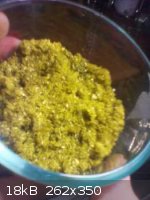
*EDIT! adding new pics and update on the synth possibly later
today! It really helps if you end up with severe
iodine/quin contamination.
[Edited on 28-2-2012 by Art&Dreams]
Life and Dreams, and chemistry.
(If you are going to do something do it right)
***random tip, saving a few$will cost you
so much more in the end.
|
|
|
homeslice
Harmless

Posts: 23
Registered: 28-1-2012
Member Is Offline
Mood: No Mood
|
|
Thats correct and its absolutely usable "as is". Dont sit on it long though as it will break down. You will notice brown/black specs forming as it
reacts with the air. Keep it stored under dessication until use.
Also, if you are an absolute stickler for purity you can recrystallize with store bought 91% IPA. Use about 1ml IPA to .8g para-benzoquinone. Most, if
not all, will dissolve as the IPA hits its boiling point. If your looking for longer crystals, for whatever scientific purpose, allow the solution to
cool slowly rather than plunging into an ice bath. Benzo grows nice long crystal lattices.
|
|
|
Ephesian
Hazard to Self
 
Posts: 97
Registered: 14-8-2012
Member Is Offline
Mood: No Mood
|
|
I used Fisher IPA, sigma Aldrich iodine chips, 30% Fisher ACS H2O2 and photograde hydroquinone. Followed the procedure that Peach gave and came out
with a black coal like product with a yellow/gold sheen. I cannot wash the black out for the life of me. I tried subliming a sample of the crude wet
product and a orange/yellow vapor filled the flask (which is a great sign that there is quinone present). Has anyone had this issue during washing?
I've spent nearly 1 L of cold IPA, and even though its dirt cheap I'd hate to continue if there is no hope. If anyone has some tricks let me know
please
|
|
|
DJF90
International Hazard
    
Posts: 2266
Registered: 15-12-2007
Location: At the bench
Member Is Offline
Mood: No Mood
|
|
I don't think you continued the reaction far enough. Perhaps your H2O2 has degraded over time or something.
|
|
|
Magic Muzzlet
Hazard to Others
  
Posts: 146
Registered: 22-7-2010
Member Is Offline
Mood: No Mood
|
|
Quote: Originally posted by Ephesian  | | Has anyone had this issue during washing? I've spent nearly 1 L of cold IPA, and even though its dirt cheap I'd hate to continue if there is no hope.
If anyone has some tricks let me know please |
I have already told of the method I use and it always works. Please try it. There is also more information outlined at The Vespiary by pyramid.
Slow addition of H2O2 is a hit or miss, usually a miss. Please try how I have explained and report back. Cool the post reaction mixture to RT over
15-20 mins before cooling in a cool bath, sometimes if you cool on ice too long the product will be contaminated with iodine so look out.
What you have obtained is quinhydrone...
|
|
|
DJF90
International Hazard
    
Posts: 2266
Registered: 15-12-2007
Location: At the bench
Member Is Offline
Mood: No Mood
|
|
I did the slow addition method and it worked fine for me. I followed a similar method to Christian on Versuchschemie (http://www.versuchschemie.de/topic,11289,-1%2C4-Benzochinon....) but I heated to 70*C before commencing dropwise addition of the hydrogen
peroxide. I also used the patent (I'm sure it was mentioned upthread) as a reference, and on one occasion I tried water as a solvent (using I2
catalysis). I found this much less simple and quite alot of iodine was noticed as vapour and sublimate in the flask. So definately use IPA. The
reaction becomes homogenous at the end. (yellowy browny solution with no green-black solids).
[Edited on 21-11-2012 by DJF90]
|
|
|
Ephesian
Hazard to Self
 
Posts: 97
Registered: 14-8-2012
Member Is Offline
Mood: No Mood
|
|
I've struck gold, just not benzoquinone
reporting back...with terrible results
@magicbullet
I followed your instruction, added the hydroquinone (55g batch size), .3 g iodine chips, and 60 g 30% H2O2, and ~150 mL IPA. Took the heat up to ~70 C
with a heat gun where an exotherm took place and went up to ~80 C. I quickly got it in an ice bath and brought it back down to 70 C and kept it going
for about 15 minutes and then slowly brought it down to 50-60 C. At this point the reaction flask was not homogenous but contained a solid mass which
coated the round bottom flask. Cooled the reaction mass down more with ice and filtered, washed with cold IPA. The crude product again resembled the
same product I obtained from using Peach's method. From the looks of it, I got quinhydrone yet again. Tell me what you think...
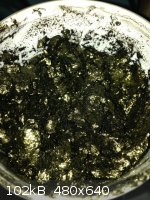
|
|
|
DJF90
International Hazard
    
Posts: 2266
Registered: 15-12-2007
Location: At the bench
Member Is Offline
Mood: No Mood
|
|
It seems like you're not letting the reaction go to completion. I've already mentioned that at the end of the reaction, it is yellow-brown in colour
and homogenous (in IPA). If there are still solids, maintain heating at say 60*C until there are not. I believe it took me a couple hours after the
slow addition of peroxide.
I've attached some pictures from a recent attempt using water as a solvent, as per the patent. I found it was not half as pleasant as using IPA.
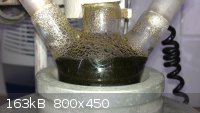 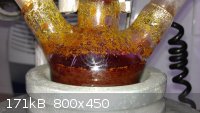 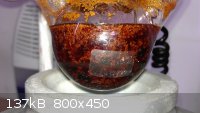
Unfortunately I do not have any pictures from the last attempt using IPA.
[Edited on 7-12-2012 by DJF90]
|
|
|
Ephesian
Hazard to Self
 
Posts: 97
Registered: 14-8-2012
Member Is Offline
Mood: No Mood
|
|
@DJF90
Do you suggest heating the hydroquinone, iodine and IPA up to ~60-70 prior to slow addition of H2O2? during addition, I assume there will be an
exotherm, so I will have to remove external heat from the mantle. Is there a specific temperature where it will definitely produce byproduct (i.e what
is the max I should let the internal temperature get to)? Also I see that everyone is using 35% H2O2, I've used the same stoichiometry with 30%, I
take it since you are using water as a solvent, the extra water from the 30% H2O2 is not affecting anything at all.
|
|
|
DJF90
International Hazard
    
Posts: 2266
Registered: 15-12-2007
Location: At the bench
Member Is Offline
Mood: No Mood
|
|
@Ephesian: I roughly followed the method outlined by Christian at VC: http://www.versuchschemie.de/topic,11289,-1%2C4-Benzochinon....
The exotherm was in my opinion not very significant, especially using IPA as solvent as the boiling point kinda helps moderate the reaction if it gets
a little excitable (use a reflux condenser). I also used 30% H2O2, as its all I had on hand. I think I left the reaction at 50*C for about 2 hours
after the addition of H2O2. Better yields can be had by leaving it longer, but I recall something like 80-90% so I wouldnt worry too much about it. I
think the patent mentions 4hrs giving quantitative yield.
|
|
|
Magic Muzzlet
Hazard to Others
  
Posts: 146
Registered: 22-7-2010
Member Is Offline
Mood: No Mood
|
|
The problem is you instantly cooled it in an ice bath, you cooled it way too much. This is a point a few have been confused on and I have had to
explain at length via pm. I only mentioned use of the bath for a few seconds to keep it from going out the condenser, later I found it never does go
that far, so I do not use an ice bath. It needs to not be cooled to actually lower temperature on the thermometer, it's a precaution to save a huge
mess (but I found in even a 500ml flask it doesn't foam that much it's fine)
After the exotherm, just leave it for half an hour. After that, scratch from the inside with the stirbar and it should begin crystallizing, or hold a
piece of ice on the side of the flask (just at a single point).
Try using 10-15% more H2O2 than you are now to compensate for both possible degradation in your peroxide and also at the said reaction temperatures in
the reaction.
|
|
|
homeslice
Harmless

Posts: 23
Registered: 28-1-2012
Member Is Offline
Mood: No Mood
|
|
Recently.
800g 91% IPA, 385g hydroquinone, and 6.2g I2 were added to a 6 liter 2 neck flat bottom flask fitted with two 400mm allihn condensers. Solution was
stirred and heated until hydroquinone dissolved completely, to about 35 degrees. Stirring was discontinued.
420g 35% H2O2 was added all at once to the solution and the hotplate was placed on HI. Stirring was kept to a minimum. Solution is brought right to
the boiling point. If the reaction becomes too violent, slow down the stirring and remove the heat. Boil 2-3 minutes.
Gas very well might escape the condensers when the B.P. is initially reached so be prepared. Gloves, glasses, respirator.
Solution was cooled at room temperature, then transferred to a freezer. Solution was vacuum filtered and at first the crystals appeared dark, almost
black, but washing them once with IPA showed nice bright yellow crystals with few, less than 5%, dark specs. Recrystallize with 300g IPA. Cool and
vacuum filter.
Yield: 341.6g
Alternatively, you can bring the solution to a rolling boil without any H2O2 and then add it dropwise into the rolling boil for a much more contained,
safer, and calmer reaction and you will get decent results, but not as good as if you just add it wholesale and then bring it to a boil. Your yield
will suffer if you go this route, however, if you have plenty of reagents, just scale it up and take the hit to yield.
Id like to add that ive tried the low heat addition over time and then letting it stir for hours. It never one time worked. All that was left was
quinhydrone. Ive tried slower H2O2 additions prior to just boiling it, and it seems like ill get less of a yield with more black sludge. Ive tried
adding the H2O2 drop by drop under reflux, not boiling, and you get nothing, just 100% black sludge. It has to boil.
And as far as the I2 is concerned. Ive seen as little a .5g I2 for every 50g Hydroquinone used. But, it seems to be more consistent using around the
actual 1.0 gram. This reaction was done with .8 gram and it worked fine.
And one more note. It seems you can be left with 3 possible ending products. The para-benzoquinone, quinhydrone, and these black specs/black sludge.
Quinhydrone is a mix of hydroquinone and parabenzoquinone that is formed by the reaction going halfway but not all the way to parabenzoquinone.
Im not sure what the black sludge/specs are but i have noticed that this forms most predominately when the solution is not brought to an absolute
rolling boil. For instance, you will get this black sludge if you add all of your H2O2 dropwise under gentle reflux where you add no heat of your own
and just let the reaction of the H2O2 heat your solution. The black sludge dissolves very readily into IPA, even ice cold IPA, whereas
parabenzoquinone will not. This is why recrystallization with IPA works best.
Also, if you end up with more black specs/sludge for whatever reason, you can always recrystallize two or three times to get down to the remaining
benzo.
Hope this helps.
[Edited on 13-12-2012 by homeslice]
|
|
|
| Pages:
1
2
3 |